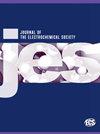Localized Surface Modification during Alternating Current Scanning Electrochemical Microscopy: Origin and Mechanism
IF 3.3
4区 工程技术
Q2 ELECTROCHEMISTRY
引用次数: 0
Abstract
In the current study, we report for the first time the observation of unintended localized surface modification on commercially pure aluminum (Al) during an alternating current scanning electrochemical microscopy (AC-SECM) analysis, its origin, and the probable mechanism responsible for it. Application of an AC perturbation potential (∼100 mV amplitude at ∼100 kHz frequency) to the Platinum ultramicroelectrode (Pt UME), during AC-SECM in acidic, neutral chloride, tap water, and alkaline electrolytes was found to cause surface modification on the scanned region of Al. An increase in the local pH of the electrolyte between the UME and the Al substrate, irrespective of the electrolyte pH (3–11) and UME biasing conditions, led to the local surface modification. The reason for the enhancement of local pH is attributed to the occurrence of higher rates of cathodic reduction reactions than that of anodic oxidation reactions. The reduction of dissolved oxygen/protons/water in the electrolytes led to the generation or consumption of OH−/H+ ions, respectively, and thus increased the pH, whereas the oxidation of Pt UME/Al surfaces decreased the pH with the generation of H+ or consumption of OH− ions. These results contribute significantly to accurately analyzing Al and its alloys using the AC-SECM technique.交流电扫描电化学显微镜下的局部表面改性:起源与机理
在本研究中,我们首次报告了在交变电流扫描电化学显微镜(AC-SECM)分析过程中观察到的商用纯铝(Al)非预期局部表面改性、其起源以及可能的机理。在酸性、中性氯化物、自来水和碱性电解质中进行交流扫描电化学显微镜分析时,在铂超微电极(Pt UME)上施加交流扰动电位(振幅∼100 mV,频率∼100 kHz)可导致铝扫描区域的表面改性。无论电解质的 pH 值(3-11)和 UME 的偏压条件如何,UME 和铝基底之间电解质的局部 pH 值升高都会导致局部表面改性。局部 pH 值提高的原因是阴极还原反应的速率高于阳极氧化反应的速率。电解质中溶解氧/质子/水的还原分别导致 OH-/H+ 离子的产生或消耗,从而提高了 pH 值,而铂 UME/Al 表面的氧化则随着 H+ 离子的产生或 OH- 离子的消耗降低了 pH 值。这些结果大大有助于利用 AC-SECM 技术准确分析铝及其合金。
本文章由计算机程序翻译,如有差异,请以英文原文为准。
求助全文
约1分钟内获得全文
求助全文
来源期刊
CiteScore
7.20
自引率
12.80%
发文量
1369
审稿时长
1.5 months
期刊介绍:
The Journal of The Electrochemical Society (JES) is the leader in the field of solid-state and electrochemical science and technology. This peer-reviewed journal publishes an average of 450 pages of 70 articles each month. Articles are posted online, with a monthly paper edition following electronic publication. The ECS membership benefits package includes access to the electronic edition of this journal.

 求助内容:
求助内容: 应助结果提醒方式:
应助结果提醒方式:


